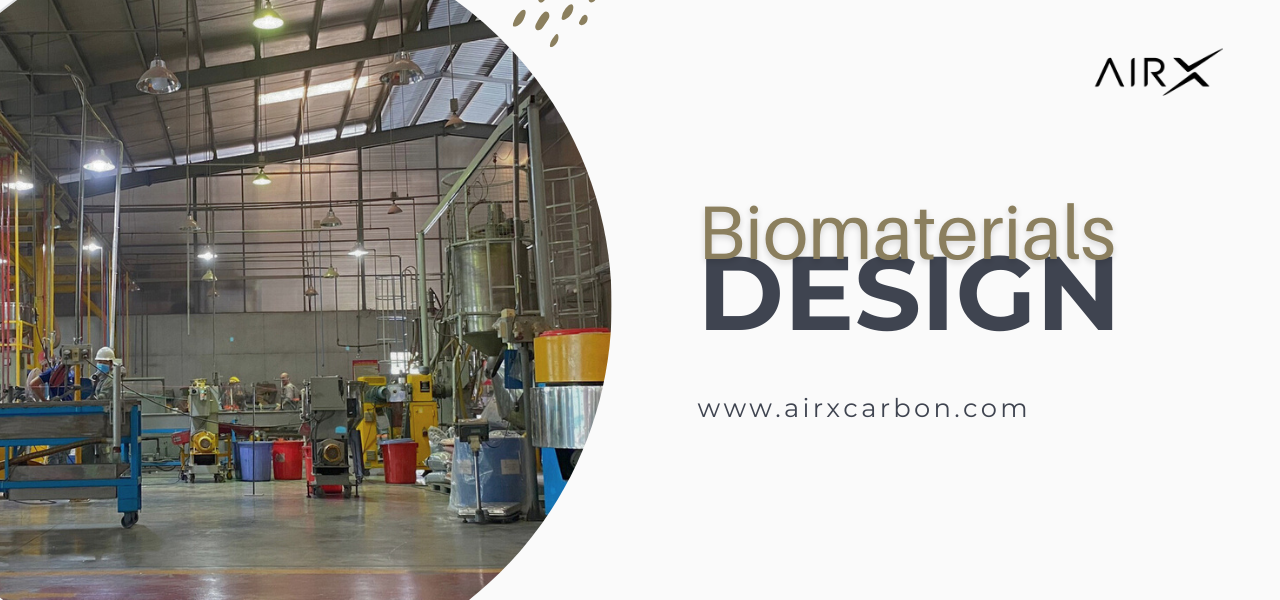Biomaterial Design: Shaping the Future

Biomaterial design is the driving force behind this revolution. It's the strategic application of scientific principles and creative ingenuity to develop these groundbreaking materials. This exciting field is pushing the boundaries of what's possible, leading to the creation of bioplastics for reduced environmental impact, biocompatible implants for medical advancements, and even self-healing materials for increased product lifespan.
In this blog, we'll delve into the fascinating world of biomaterial design. We'll explore the biomaterial design process, a captivating fusion of science and creativity. We'll showcase how companies like AirX Carbon are leading the charge with innovative approaches. Most importantly, we'll uncover the exciting possibilities that biomaterial design holds for a more sustainable future.
A World Beyond Traditional Materials – Enter Biomaterial Design
For centuries, we've relied on traditional materials like metals, plastics, and ceramics. However, their limitations – environmental impact, non-renewability – are becoming increasingly clear. This is where biomaterial design emerges as a powerful tool.
Biomaterials, in essence, are a class of materials specifically designed to interact with our environment in a harmonious way. Biomaterial design takes this concept further, focusing on the strategic application of science and creativity to develop innovative biomaterials with targeted functionalities.
In the realm of sustainability, biomaterial design plays a crucial role in developing bioplastics. These are bio-based materials offering a promising alternative to traditional plastics. Biomaterial design allows for the creation of bioplastics with specific properties: biodegradability for reduced environmental impact, potential for carbon negativity, and even improved functionality compared to traditional plastics.
By pushing the boundaries of material science, biomaterial design for bioplastics offers a glimpse into a future where materials are not just functional, but also sustainable and environmentally responsible. This exciting field is poised to revolutionize various industries, from packaging and consumer products to construction and beyond, shaping a future where functionality meets environmental responsibility.

Products from Biomaterial Produced by AirX Carbon
The Biomaterial Design Process: A Fusion of Science and Creativity
Biomaterial design isn't just about science; it's a captivating blend of scientific principles and creative ingenuity.
Imagine a team where biologists, material scientists, and engineers come together. Biologists provide a deep understanding of living systems and their interaction with materials. Material scientists bring their expertise in material properties and behavior. Engineers translate these insights into practical applications. This collaborative spirit is the heart of biomaterial design.
So, how does this translate into an actual design process? It typically involves several key steps:
- Identifying the Need: The process begins with a clear understanding of the desired function. What problem are we trying to solve with this biomaterial? This could be anything from creating a biodegradable food container to designing a biocompatible implant.
- Material Selection: Based on the identified need, biomaterial designers explore various options. They consider factors like material properties (strength, flexibility, biodegradability), manufacturing feasibility, and cost. Bioplastics, for instance, might be a viable choice if biodegradability is a key concern.
- Material Modification & Optimization: The chosen biomaterial might need adjustments to achieve the desired functionalities. Biomaterial designers may explore techniques like blending different materials or incorporating specific additives to optimize performance.
- Prototyping & Testing: Once a promising design is established, it's time to create prototypes for further testing. These prototypes undergo rigorous testing, both in controlled environments and, in some cases, real-world conditions. This helps ensure the biomaterial performs as intended and meets safety and regulatory requirements.
The biomaterial design process is a continuous loop of innovation and refinement. By constantly learning from test results and adapting designs, biomaterial designers create groundbreaking materials that are not only functional but also sustainable and biocompatible.
AirX Carbon - Biomaterial Design
AirX Carbon: A shining example of biomaterial design innovation, AirX Carbon goes beyond generic bioplastics. Their focus lies in creating Carbon Negative Custom Material Solutions (CMS) specifically tailored for Original Equipment Manufacturers (OEMs).

AirX Carbon's Custom Material Solutions (CMS)
This commitment to collaboration is backed by a robust ISO-based quality management system, ensuring consistent excellence in every project. Partnering with AirX Carbon allows businesses to not only reduce their environmental impact but also gain access to cutting-edge, high-performance biomaterials for a sustainable future.
Beyond Generic: Biomaterial Design for Diverse Applications
The true power of biomaterial design lies in its versatility. Biomaterials can be customized with specific properties, opening doors to a vast array of applications. Imagine eco-friendly packaging derived from plants or construction materials boasting superior insulation properties. The possibilities are truly endless.
AirX Carbon: Your Collaborative Partner in Biomaterial Design
AirX Carbon doesn't just offer biomaterials; they offer a collaborative partnership. They work closely with clients to understand their specific needs and develop biomaterial solutions that perfectly align with those requirements. This ensures that businesses can leverage the power of biomaterial design to create sustainable and innovative products.
The Future is Bio-Based: AirX Carbon Leading the Charge
The future of materials is undoubtedly bio-based, and companies like AirX Carbon are at the forefront of this revolution. Their unwavering commitment to innovation, tailored biomaterial design solutions, and focus on carbon negativity pave the way for a future where biomaterials become the go-to choice for businesses seeking sustainable and functional alternatives.
Learn more at: Top Biomaterial Companies Leading the Bioplastics Charge
Contact us
AirX is the world’s first carbon-negative bio-material made from coffee grounds manufacturer.
We specialize in producing bio-based composites using recycled carbohydrates derived from by-products such as coffee grounds, coconut husk, husk, and bamboo. Our goal is to promote sustainability through the use of eco-friendly materials.
We are always here to help and provide the best service possible. If you have any questions or would like to receive advice and feedback directly from our sales staff, please do not hesitate to contact us. You can reach us through:
- Whatsapp: +84 969 742 950
- Email: [email protected]
We look forward to hearing from you!

